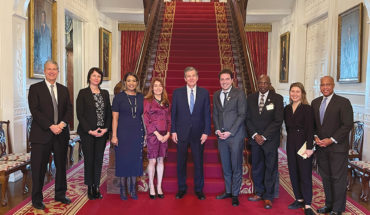
“There’s a fine line ballet costumes need to straddle between distinction and invisibility,” says Martinsen. “They need to be characteristic of a time, a place, and a character, but never detract – or distract – from a dancer’s artistry.”
by Liza Roberts
photographs by Jillian Clark
At Carolina Ballet headquarters, in a fluorescent-lit workroom where sewing machines whirr, scissors snip, and tutus sway in the rafters, costume director Kerri Martinsen orchestrates an unusual sort of dance. Like the work of the ballerinas across the hall, hers requires talent, precision, grit, coordination, and practice.
But when she’s finished, Martinsen won’t take a bow to an auditorium of applause. Instead, she’ll be happy if her work attracts little attention. “The dancing takes priority over everything else,” she says. “When there’s nothing glaringly obvious” about her costumes, she says, she knows she has succeeded. “A passing comment” about their beauty “is almost better” than effusive praise. “You want people focusing on the dance.”
Carolina Ballet fans certainly do that. The small but mighty ballet company is nationally renowned for its excellence and also for its originality. Several times a year, the company creates and performs new ballets – sometimes as many as six new ballets in a single year. Amazingly, in its 19 years, Carolina Ballet has produced more new work than any other ballet company in the country besides the New York City Ballet. Choreography, costumes, scenery, lighting, and sometimes the score – all are new. Many of these new ballets call for minimalist costumes designed to showcase a dancer’s body and the beauty of movement.
Then there are the story ballets. Theatrical productions like Swan Lake, The Nutcracker, and Firebird. At the Carolina Ballet, a new story ballet comes up rarely. When it does, the work that Martinsen and her team put into the costuming is a feat to behold. Story ballets involve enormous casts and costumes that can’t just melt into the background – they need to help build character, showcase dramatic action, and tell a story. And then they need to get out of the way so the dancers can shine.
When Carolina Ballet debuts its much-awaited Macbeth on April 14 – the first full-evening story ballet it has produced since Don Quixote in 2008 – it will feature choreography by artistic director Robert Weiss; an original score by J. Mark Scearce; scenery by Jeff A.R. Jones; lighting by Ross Kolman; and costumes created by a small and talented army of workers that includes principal guest costume designer David Heuvel; eight far-flung seamstresses and tailors working remotely from Florida to Oregon; a temporary in-house costume-making team of five; and the orchestration and ingenuity of Martinsen, who acts as maestro.

Martinsen fits a Lady Macbeth costume on dancer Lara O’Brien. “At first, you want it to look a certain way – but then you have to let it go,” Martinsen says. “Things change very quickly once you get them on bodies and they’re dancing.”
Modestly, Martinsen likens her role to that of a general contractor, and it’s true that she operates under a similar kind of get-it-done imperative. “The architect does the drawings,” she says – in this instance, the “architect” is Heuvel, a renowned ballet costume designer whose full-time job is costume production director at Ballet West in Salt Lake City, Utah – “and the general contractor takes all of these drawings and figures out how to turn it into a building.”
But the efficiency and creativity Martinsen brings to her role is more like that of a conductor – one with a diffuse, far-flung, multi-talented orchestra, a modest budget, and a curtain about to rise.
For Macbeth, the “building” behind that curtain will involve 130 new costumes that involve three to eight pieces each. They range from snug doublets, headpieces, dresses, shirts, peignoirs, leotards, nightgowns, capes, armor, and pants to fluffy under-armor shirts known as gambesons. Principal dancer Lara O’Brien as Lady Macbeth alone has eight costumes including a wedding dress, a “murder dress,” a “morning-after-murder dress,” a banquet gown, and two pregnancy pads to take her through 9 months.

As artistic director Robert Weiss looks on, dancer Miles Sollars-White is fitted for the costume he will wear as a fighter on the battle team of Scots led by Macbeth and Banquo.
Which is less time than it takes to sew them all. “We started talking about the costumes back in May,” Martinsen says. “You have to plan, and you have to be flexible.” Indeed, it’s a process. Making a ballet costume is not like making a dress, she points out. “If you think of a typical dress,” she says, “you might wear it three or four times a year. A costume gets worn 11 times in a month. And it gets very sweaty.” So it needs to be durable, flexible, adjustable, cleanable, and lightweight. It needs to come off with lightning speed and go back on the same way. Importantly, it also needs to last for years to come. “We build to re-do,” she says. “You’re never going to reap your investment in one year. We hope we can use them again, and again, and again.”
The colorful tutus fluttering overhead are a case-in-point: They’re for Nutcracker, dusted-off, and repaired year after year. In a nearby warehouse, the ballet stores costumes (and scenery) for 30-odd productions, including Carmen, Romeo & Juliet, Beauty and the Beast, and The Little Mermaid. By May, Martinsen’s creations (and the dramatic boulders of Jones’s new scenery) will take their place beside these others so they, too, can be used again, a down payment on years of Macbeths to come.
It’s no small matter. The budget for the Macbeth costumes – including travel for Heuvel, shipping back and forth, the additional staff, all of the freelance work – is more than $100,000, or a fifth of the production’s entire budget of more than $500,000. It helps that the company has supporters who believe wholeheartedly in what it does. Carolina Ballet says funding for Macbeth was made possible through a grant from the John William Pope Foundation, in conjunction with a significant anoymous gift from a North Carolina family. Without that kind of major philanthropic support, Carolina Ballet wouldn’t be in a position to create so boldly.
Artistic director Weiss says he has long dreamed of choreographing a ballet to Macbeth, but couldn’t find music to do it justice. He’s not alone. The only other known Macbeth ballet in the world, Carolina Ballet says, was choreographed by Russian dancer Vladimir Vasiliev for the Bolshoi Ballet in 1980, and was in the repertory there for only a short time. But after Weiss and Scearce received a fellowship from New York University’s Center for Ballet and the Arts in 2015, they spent five weeks over the summer working together on a libretto and score for their imagined Macbeth. Now that music will be played live by the Chamber Orchestra of the Triangle, yet another creative contributor to the massive Macbeth undertaking.
‘It’s never the same job twice.’
While the result of so many creative minds working together is expected to be remarkable, the day-to-day work that makes it come together is just that: work. Back in the costume room, Martinsen, who is in her sixth season at Carolina Ballet, is used to it. After earning a master’s degree in costume production from UNC-Chapel Hill, she spent four years at the Washington National Opera and worked for a traveling theater company before moving back to the Triangle.
Her talent got her in the door at Carolina Ballet, but her ingenuity might be one of her most impressive traits. To do her job well, she has to be adept at skills as unrelated as inventory control and pattern-making; team-building and design; project management and budgeting.
And she’s as parsimonious as they come. Instead of railing against her tight budgets, Martinsen relishes the challenge, peppering her conversation with stories of making something out of nothing, scoring great deals on supplies, finding terrific sub-contractors, eliminating waste.
Instead of risking the chance that the building’s cleaning crew might sweep away a dropped pin or scrap of fabric, for instance, Martinsen foregoes their services. Once a week, she or a staff member sweeps the floor themselves so they can comb the pile for fallen treasures, running a magnet through the dust to capture dropped pins and needles. When she needed another sewing machine, she found one from the 1950s in storage and got it working again. When Danskin discontinued the tights the company had used for years, Martinsen found a cache of them online and bought enough at a cut rate to last for years to come. When it’s time to buy safety pins and other supplies, Martinsen waits until she has $100 worth of “notions” lined up so she can get free shipping. When she found a new source for the flesh-colored mesh she uses for many costumes at a rate less than half of what she’d paid before, she was plainly thrilled. She can tell you the cost-per-yard of every fabric she uses without pausing to think.
The silk jersey for Lady Macbeth’s nightgown: $35/yard.
The “mermaid sequins” fabric she’s tinkering with for Lady Macbeth’s “murder dress”: $25/yard.

Spray-painted “mermaid sequins” will allow Lady Macbeth to appear to wipe blood from her hands with a sweep of her hand.
The tinkering itself is another example of ingenuity. In the famous “Out, damned spot!” scene toward the end of the ballet, a sleepwalking Lady Macbeth wipes her hands on her dress and leaves a trail of blood, representing the murders she and her husband have orchestrated. Martinsen didn’t want to use liquid stage blood – “it likes to get on everything except where it’s supposed to be,” she says, and is hard to wash out – so she decided to experiment with fabric. She’d seen a kind of sequined fabric that allows the sequins to completely flip over when smoothed in different directions, and bought a single yard online from a supplier in Los Angeles. When it arrived, she spray painted one side a dull white, the other a distinctly bloody red. With a sweep of her hand, O’Brien can now make the fabric appear to trail blood. The whole thing took a couple of days to get right, Martinsen says – but the result is a permanent solution to a problem that could have been a constant mess.
She credits her small seasonal staff – as well as Heuvel, the designer, and the eight freelancers who are working remotely to create a huge number of costumes – for making it all possible. When Heuvel came to town in early March to check on the progress, he requested countless changes, from the length of hems to the placement of seams, which then had Martinsen and her crew doubling back to catch up. “It’s such a pigeonhole skill set,” she says of her staff and the freelancers. At press time, she was waiting for The Lion King to close at DPAC at the end of March so she could get the help of three additional talented costume-makers who were temporarily working the Broadway show as dressers and costume repairers.
In the meantime, a month before Macbeth’s premiere, Martinsen’s workroom is nonstop action. “We’re a long way out,” she says. From the corner, a seamstress shouts out: A shirt is complete! “Yay!” Martinsen says. “That’s two shirts done.” Two pieces down, hundreds to go. But once it gets rolling, Martinsen says, all of the initial hard work – the research, the design, the pattern-making, the trips, the fittings, the tweakings – it all bears fruit surprisingly quickly. “It’s like construction,” she says, continuing her earlier analogy. “You see a construction company digging in the dirt, digging in the dirt for a long time, and then boom! The building goes up.” And it’s a beauty.
The cast
Macbeth: Marcelo Martinez
Lady Macbeth: Lara O’Brien
Macduff: Richard Krusch
Lady Macduff: Margaret Severin-Hansen
Banquo: Pablo Javier Perez
Three Witches: Alicia Fabry, Alyssa Pilger, Lindsay Purrington
Hecate: Randi Osetek
Macbeth will be performed at Raleigh Memorial Auditorium April 14-17 and at Durham Performing Arts Center April 30-May 1.
Tickets: carolinaballet.com












